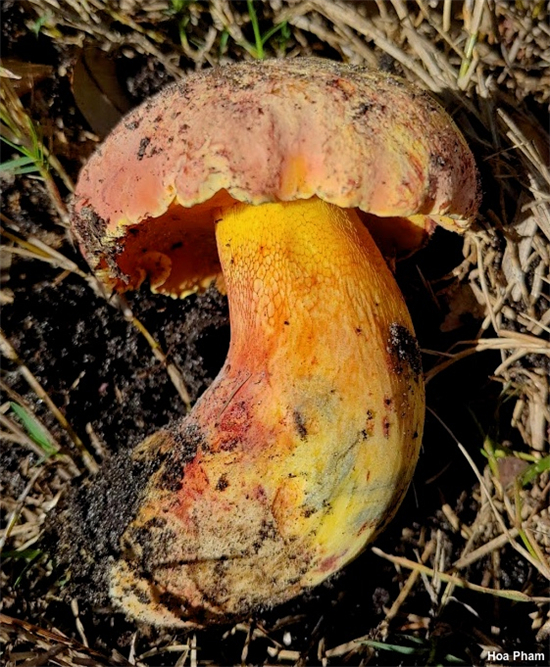
This southern bolete was originally described from Florida (Singer 1945) as a variety of Butyriboletus frostii, differing in its duller cap colors and less dramatically reticulate stem. It was later elevated to species status by Murrill (1945), and contemporary DNA-based studies (e.g. Kuo & Ortiz-Santana 2020) support Murrill's idea, as well as placement in the genus Butyriboletus.
Identifying features for Butyriboletus floridanus include its association with southern oaks (especially southern live oak), its variable colors (the cap is usually pink but ranges to red and yellow, and the pore surface ranges from yellow to red), its blue-bruising surfaces, and the red reticulation on the stem.
Boletus floridanus and Exsudoporus floridanus are former names.
Thanks to Hoa Pham for documenting, collecting, and preserving Butyriboletus floridanus for study; her collection is deposited in The Herbarium of Michael Kuo.
Description:
Ecology: Mycorrhizal with oaks, including southern live oak, Chapman oak, and swamp laurel oak; growing alone, scattered, or gregariously; spring through fall; Gulf Coast states and lower Atlantic states, inland to Tennessee; also known from Mexico and Belize. The illustrated and described collection is from Florida.
Cap: 4–8 cm; convex, becoming broadly convex; tacky when fresh, but soon dry; more or less bald; color ranging from pink to pale, dull red, or orangish yellow—or mottled yellow and pink; when young covered with a whitish to yellowish bloom; the margin often yellow, with a small, overhanging, sterile portion.
Pore Surface: Ranging from yellow to orange or orangish red or pinkish red; bruising blue to blackish; 1–2 pores per mm at maturity; tubes dull yellow, bruising blue, to 1 cm deep.
Stem: 4–7 cm long; 1.5–2.5 cm thick; equal; reticulate overall or for the upper one-half or so, with a red reticulum; when young covered with a whitish to yellowish bloom over the bottom half (and, when this is the case and the reticulation is present in the bottom portion of the stem, the ridges can appear whitish or yellowish); ground color varying from yellow to orange or reddish orange; bruising blue to nearly black; basal mycelium whitish to yellowish.
Flesh: Yellow to yellowish or whitish overall, with dark red dots in the stem base; bluing when sliced.
Odor and Taste: Not distinctive.
Spore Print: Olive brown.
Microscopic Features: Spores 11–16 x 4–5 µm; fusoid; smooth; golden in KOH. Hymenial cystidia 40–55 x 4–7 µm; fusiform or lageniform; smooth; thin-walled; hyaline in KOH. Pileipellis a partially gelatinized cutis; elements 2.5–4 µm wide, smooth, hyaline to orangish in KOH.
REFERENCES: (Singer, 1945) G. Wu, K. Zhao & Z. L. Yang, 2016. (Both, 1993; Bessette, Roody & Bessette, 2002; Ortiz-Santana et al., 2007; Bessette, Roody & Bessette, 2016; Kuo & Ortiz-Santana, 2020.) Herb. Kuo 10281905.
























